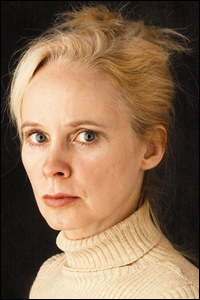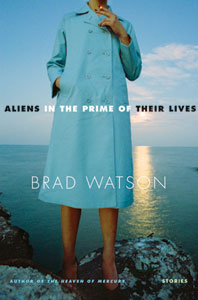 Brad Watson was born in Meridian, Mississippi. He studied at Mississippi State University and The University of Alabama, has taught at Alabama, Harvard, The University of West Florida, Ole Miss, The University of California at Irvine, and now in the MFA Program at The University of Wyoming. He’s published three books: Last Days of the Dog-Men (winner of the Sue Kaufman Prize for First Fiction from the American Academy of Arts and Letters), The Heaven of Mercury, and (in 2010) Aliens in the Prime of Their Lives. His stories have have appeared in places like Narrative, The Oxford American, Greensboro Review, Idaho Review, The New Yorker.
Brad Watson was born in Meridian, Mississippi. He studied at Mississippi State University and The University of Alabama, has taught at Alabama, Harvard, The University of West Florida, Ole Miss, The University of California at Irvine, and now in the MFA Program at The University of Wyoming. He’s published three books: Last Days of the Dog-Men (winner of the Sue Kaufman Prize for First Fiction from the American Academy of Arts and Letters), The Heaven of Mercury, and (in 2010) Aliens in the Prime of Their Lives. His stories have have appeared in places like Narrative, The Oxford American, Greensboro Review, Idaho Review, The New Yorker.
You can read Brad’s story “The Misses Moses,” from Aliens in the Prime of their Lives, on Fictionaut.
What stories/books do you feel closest to?
So Long, See You Tomorrow, William Maxwell
Blanco, Allen Wier
Ron Carlson stories
The Death of a Beekeeper, Lars Gustafsson
and his story, “Greatness Strikes Where It Pleases”
My Antonia, Cather
Stoner, John Williams
Airships, and Ray, Barry Hannah,
Selected Stories, Welty
and “No Place for You, My Love”
A Good Man Is Hard to Find, O’Connor
As I Lay Dying, Faulkner
Taking Care, and Escapes, Joy Williams
especially “The Farm”
“Gooseberries,” Chekhov
“The Awakening,” Babel
The Ice at The Bottom of The World, and Charity, Mark Richard
especially “Strays,” “The Birds for Christmas,” and “Memorial Day”
The Moviegoer, Percy
Slaughterhouse Five, Vonnegut
Trout Fishing in America, The Hawkline Monster, Willard And His Bowling Trophies, Brautigan
“Bruns,” Norman Rush
The Shell Collector and Memory Wall, Anthony Doerr
Mrs. Bridge, Evan S. Connell
Edisto, and Typical, Padgett Powell
Collected Stories, Lydia Davis
Night Work, Christine Schutt
“Me and Miss Mandible,” and “Robert Kennedy Saved from Drowning,” D Barthelme
With, Donald Harrington
The Lover, M Duras
The Restraint of Beast, Magnus Mills
and many, many more, many by friends it would be dangerous to begin naming because I would forget some no doubt.
Does teaching writing effect your own work?
I love my students because of, as I’ve said recently, their beautiful young minds. I teach for the money, of course, like everyone else, but what makes it worthwhile is knowing the younger writers.
I don’t think teaching affects my writing one way or the other. Sometimes, reading so many works-in-progress drains the well, and you have to have time off and then read the best books you can find in order to clear the critical voice from your head.
How do you like living in Wyoming and does it play a role in your writing?
Wyoming is beautiful and I hope it’s giving me more to write about (eventually), more than my own so-far ridiculous experience as a ridiculous child and so-called adult.
How do you stay creative? What are your tricks to get “unstuck?”
The best thing is to keep finding great, beautiful stories and novels, for me. Reading a great book I hadn’t read before always revives me. As for getting unstuck, anything that can distract me from the narrow rutted path of mundane thought: anything from a plain old shower or bath to a long, long drive, a long hike or bike ride in the mountains, or just giving it up for a while in the knowledge that I’ve become my own worst enemy and I cannot defeat me and so I let me pass.
Give us an exercise – your favorite writing exercise…
I love the Meg Pokrass exercise of Google translating a fucked-up story into another language and then Google translating it back into English to see how that particular insanity may re-fuck-up the story in a good way. That’s the best one I’ve heard lately. But I don’t do exercises, myself. I sometimes ask my students to do an exact structural imitation of a story in order to surprise themselves with the ingeniousness of the way that story (word by word) is put together.
What are you working on now?
Aliens In the Prime of Their Lives is a collection of stories is just recently out. Now, I’m working on a novel, when I’m not working on two other novels I have in the drawer, plus two or three new short stories. But, unlike some other writers such as the ingenious and prolific Richard Bausch, I often don’t write very well or much when I’m in the thick of teaching. Call it ADD or BWISANIDIOT.
You have dogs now, and have often owned dogs. I read somewhere that the stories in your first collection was inspired by the dog/dog owner connection. Can you talk about how animals and people are connected, or the importance of having dogs for you, in your life?
We have two dogs now but actually they’re the first dogs I could call my own. My brother had a couple of dogs while we were growing up, but they were HIS dogs. I had a cat along with my second marriage, the greatest fat cat in the world, who was much like a dog and who liked to box the ears of small dogs just for fun and out of meanness. He came when you whistled.
The first book came from overhearing an anecdote about a woman who’d put her husband’s dog to sleep as revenge for his cheating. I wrote a story, then a disjointed novel, from that, with a lot of anecdotal, observational, and newspaper research, and then when the novel failed I broke out 9 stories from it. They became the first book. I think the main idea in the book is expressed best by the words I quoted as epigraph for it, from the book Myths of the Dog-Man by David Gordon White: “Ultimately, the dog, … its constant presence in human experience coupled with its nearness to the feral world, is the alter ego of man himself.”
What do animals offer humans that humans usually do not offer humans?
Unconditional forgiveness, as if they’re dog God.
Can you share any experience you’ve had with social media that has been helpful for you? Favorite websites? What can we as writers ultimately hope to do in terms of self-promotion and how do we do it in a way that seems genuine? Any thoughts about this, actually…
I’m still wondering how to do this, how to use these things. I’m a former newspaper reporter from the days just after they’d first started using computers. I’m a dinosaur. I’m trying to figure it out. I am on Facebook but I don’t use it very well. I have a website and although I’ve posted a lot of links to reviews, interviews, and so on, plus two pictures, and a reading schedule, I haven’t written a single blog entry. Pretty lame. I’m going to try to start using the blog, though, once I figure out just what I’d like to write on it.
How long does it take you to write a short story?
Anywhere from one day to 30 years.
Why do you write longer first drafts when you write longhand — longer than first drafts on the laptop, say, which one would think more probably leads to garrulousness?
Because I can’t tell how long it’s becoming as I write it — my handwriting is poor, and I can’t mentally convert handwritten page to typed page — and because I think I care less how long it’s becoming, and maybe that’s because I’m having more fun writing it when I’m writing longhand. I should do it more often, even if I do have to cut more. It may mean I get in more interesting things more often, who knows.
The Fictionaut Five is our ongoing series of interviews with Fictionaut authors. Every Wednesday, Meg Pokrass asks a writer five (or more) questions. Meg is the editor-at-large for BLIP Magazine, and her stories and poems have been published widely. She blogs at http://megpokrass.com.
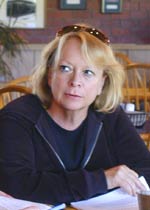 Jane Ciabattari
Jane Ciabattari

 By all accounts, the
By all accounts, the 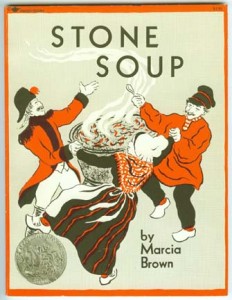
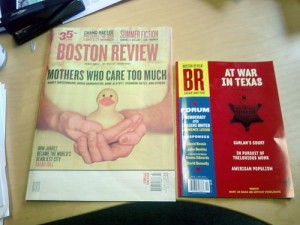 Boston Review redesigns.
Boston Review redesigns. Brad Watson
Brad Watson We’re happy to announce
We’re happy to announce 